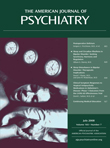Issues for DSM-V: The Medical Diagnostic Model
Early in the modern psychopharmacologic era, treatment response was considered verification for a diagnosis. A well-developed response to lithium in excited patients was consistent with a diagnosis of manic depression. A response to anticonvulsants supported a diagnosis of a seizure disorder. As syndrome categories broadened in scope and became less specific (e.g., the easily met criteria for major depression), the usefulness of such responses fell and interest waned.
In the 1970s, hypercortisolemia was reported among severely depressed patients but not in patients with other mental disorders. Initial observations were made in patients with melancholic depression who were so ill they were referred for electroconvulsive therapy. The abnormality disappeared with remission and reappeared with relapse. The development of a simplified dexamethasone suppression test encouraged studies. However, when the test was applied as diagnostic criterion to populations classified according to DSM-III criteria for major depression, specificity was lost and the test was precipitously discarded. Recent interest in rigorously diagnosed examples of melancholia and psychotic depression based on narrowly defined mood, motor, and vegetative symptoms suggests that hypercortisolemia may be a verifying criterion and the response to specific treatments a validating criterion (1) .
Psychiatric classification has swollen into a kaleidoscope of putative disorders. It is not likely that any one rule of taxonomy will define the many entities that may be included in DSM-V. But a medical diagnostic model will define those conditions for which we already have a biological interest in their identification and, more importantly, methods of resolution.
1. Taylor MA, Fink M. Melancholia: The Diagnosis, Pathophysiology, and Treatment of Depressive Illness. Cambridge, UK, Cambridge University Press, 2006Google Scholar



